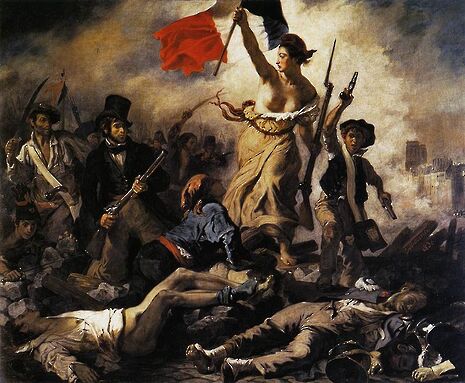Modern heroism
Lucrezia Baldo on Printmaking and the legacy of Napoleon Bonaparte

Modern Heroism marks the 200th anniversary of the Battle of Waterloo. Its purpose is to tell the story of that period not by creating another biography of Napoleon, but rather by looking at it from the point of view of emergent print culture. The series of lithographs on show illustrate how the concept and perception of the figure of the hero was transformed at the beginning of the 19th century.
Lithography, a printmaking technique invented in 1796 by German author and actor Alois Senefelder as a cheap method of publishing theatrical works, which emerged at the same time as other changes brought about by political turmoil and industrialisation. Curator of the exhibition, Amy Marquis, notes that “lithography was a remarkably fast printmaking technique”. The immediacy with which the press could respond to events made it the perfect medium to react to social and political issues.
Artists who supported Napoleon’s regime immediately adopted this method to glorify the Emperor’s military exploits. Political in nature, these prints demonstrate nostalgia for a past age and its conception of the ‘hero’. The exhibition is displayed to offer a certain progression; from formidable historical battle scenes, such as Gérard’s ‘Battle at the Milvian Bridge’, we pass to more poignant scenes that emphasise the contrast between the glorious past and the decay of post-Napoleonic France, as in Charlet’s ‘Support me Chatillon… I am about to faint!’ The work of artists such as Vernet, Charlet and Raffet appealed to the now unemployed soldiers of the Napoleonic army as much as to the educated middle class. They contributed to create Napoleon’s legacy and they still influence much of the conversation about him today.
Yet, what is really fascinating about the exhibition is how well it conveys the change in attitude towards the notion of hero in the post-Napoleonic period. This is the time when writers such as Balzac and Hugo were shifting the focus of literature towards a new heroic figure, a much more humble one. In his ‘On the heroism of modern life’ in 1846, Baudelaire wrote:
“The majority of artists who have attacked modern life have contented themselves with public and official subjects, with our victories and our political heroism... However, there are private subjects which are much more heroic than these. There are such things as modern beauty and modern heroism. The life of our city is rich in poetic and marvellous subjects.”
The same transformation can be perceived in lithography. Prints of valorous soldiers are quickly replaced by political and social critique. This gives birth to beautiful prints such as Auguste Raffet’s ‘Freedom or death!’, which visually references Delacroix’s famous ‘Liberty Leading the People’. It commemorates the July Revolution of 1830, during which Parisian citizens overthrew the Bourbon regime. Another highlight of the exhibition is its collection of satirical caricatures.
With his prints, Honoré Daumier, and his publisher Charles Philipon, directly challenged the corrupt and blundering government of Louis-Philippe I and the restrictions imposed on the freedom of expression. At the time, caricatures were considered outside the ‘serious’ arts and they were seen as dangerous by the regime. Censorship represented a great issue for contemporary artists, who often faced incarceration and fines.
Two lithographs that will certainly catch your attention are Daumier’s ‘Damn! Those boots are happier than their master! They drink!’, and Desperet’s ‘Attack of Detached Forts by the 1st Regiment of Press Gunners’. These caricatures are amusingly provocative, and they illustrate the poverty and injustice of post-Napoleonic France.
The latter depicts an inventive pear-shaped fort with a face attacked by the French press. Philipon, who had invented the caricature of the King as a pear, was imprisoned for five months for this offence. The modern ‘heroes’ were now the poor in their daily struggle for survival and the intellectuals who, holding their pens tight in their hands, protected the precious right to freedom of expression.
This exhibition of artistically beautiful lithographs helps us to understand our modern society and the impact that the press has on us in shaping our notion of heroes, and the events that form them. It also highlights the importance of freedom of expression in France and the rest of the world, urging us not to ignore attacks on this right. Given recent events in Paris, and the continued censorship of media in countries all over the world, this lesson remains painfully necessary.
The exhibition is open now at the Fitzwilliam Museum and runs until 28th June 2015
 Interviews / You don’t need to peak at Cambridge, says Robin Harding31 December 2025
Interviews / You don’t need to peak at Cambridge, says Robin Harding31 December 2025 Comment / What happened to men at Cambridge?31 December 2025
Comment / What happened to men at Cambridge?31 December 2025 News / Unions protest handling of redundancies at Epidemiology Unit30 December 2025
News / Unions protest handling of redundancies at Epidemiology Unit30 December 2025 News / Varsity’s biggest stories of 202531 December 2025
News / Varsity’s biggest stories of 202531 December 2025 News / Downing investigates ‘mysterious’ underground burial vault 29 December 2025
News / Downing investigates ‘mysterious’ underground burial vault 29 December 2025









